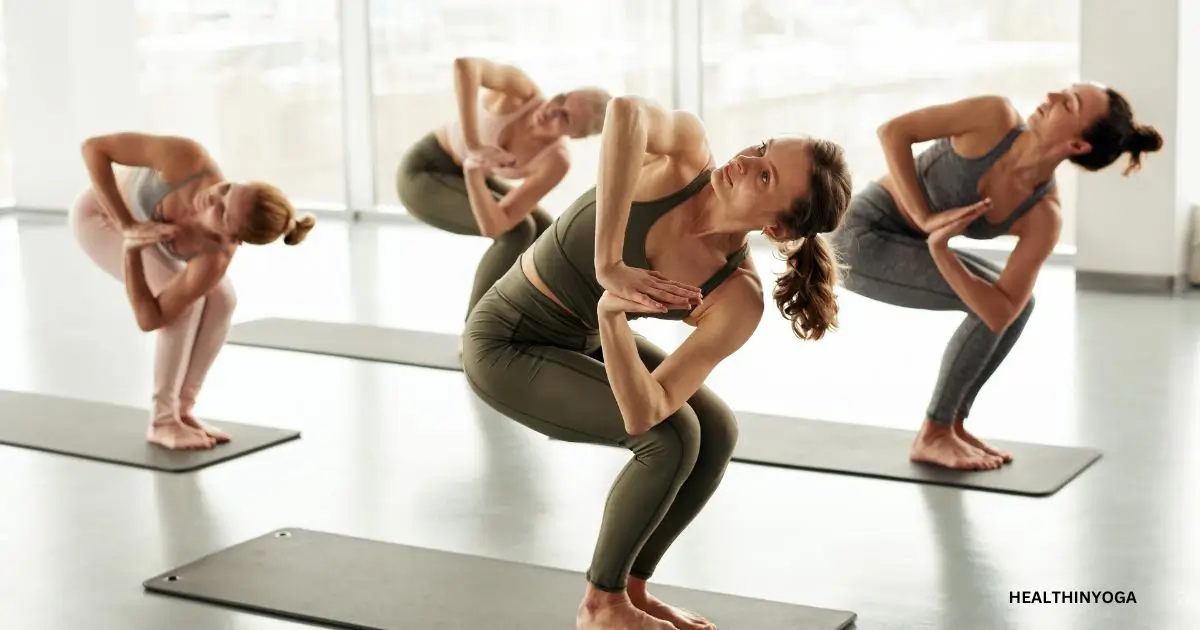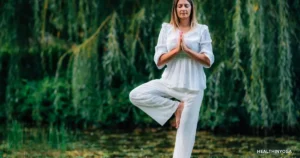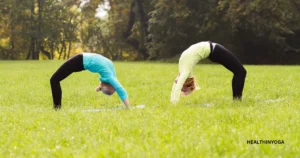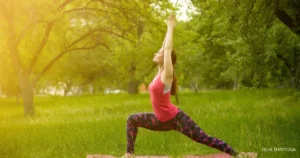Last updated on June 26th, 2024 at 12:34 pm
Introduction
The Revolved Chair Pose is a more intense and powerful variation of the basic chair pose. This pose activates many organs and chakras including the Sacral and Root chakras. It is more deep standing stretching twisted pose and adds more challenges to your yoga routine. “PARIVRTTA UTKATASANA” is the Sanskrit language-derived name of this pose which means
Parivrtta – Revolved or Twisted
Utkata – Intense or Powerful
Asana – Pose or Posture
In this article, we explore the best and most challenging variation of Chair Pose. The revolved chair pose has amazing benefits, and some associated risks and safety precautions. We learn the right way to do this pose without any difficulty.
Basic Of The Revolved Chair Pose
It is a detoxifying pose that strengthens your lower body. It is a beginner-level standing-twisted chair pose in which you twist your torso and balance a chair position.
- Level – Beginner
- Position – Standing Twisting
- Other Name – Parivrtta Utkatasana or Twisted Chair Pose
- Target Muscles – Lower Back, Quadriceps, Hamstrings, Hips, and Core Muscles.
Benefits Of The Revolved Chair Pose
This variation of the utkatasana, the revolved chair pose is a powerful pose among all variations. It offers many benefits to your physical and mental health and well-being. It will expand and open the chest, shoulders, and upper back. Strengthen the glutes, thighs, ankles, and lower back.
This pose stimulates the abdominal and heart organs and increases balance and focus. It improves joint range of motion and reduces the risk of injury at ankles, shoulders, and knees. Here we discuss some amazing benefits of this pose given below
- This pose increases the strength and stability of the muscles. This pose engages various muscles including the core, back, shoulder, and legs. That can help strengthen the glutes, core, quads, and hamstring muscles.
- This pose offers intense twisting motion that helps stretch the spine, shoulders, chest, and hips. This twisting action increases flexibility and improves the range of motion. These flexible and strong muscles are free from stiffness and reduce the risk of injury.
- This Pose stimulates the digestive and abdominal internal organs that improve your digestion. Twisting motion massages the internal organs and maintains their health.
- Standing twisted pose increases the energy levels of the entire body. It improves blood circulation and blood flow in the body and increases oxygen levels.
- This pose helps reduce anxiety and stress and improves your mental health. Regular practice of this pose can encourage mindfulness and a sense of calm. Deep breathing during the posture can promote relaxation and peace of mind.
- The intense twisting motion of this pose improves the flexibility of the spine. Alleviate the lower and upper back pain and correct the posture.
How To Do Revolved Chair Pose(Parivrtta Utkatasana)
This pose is a standing twisting pose belonging to the beginner level. Here we explain the step-by-step guide to practicing Parivrtta Utkatasana without facing a problem. Before performing this pose read carefully all the instructions given below
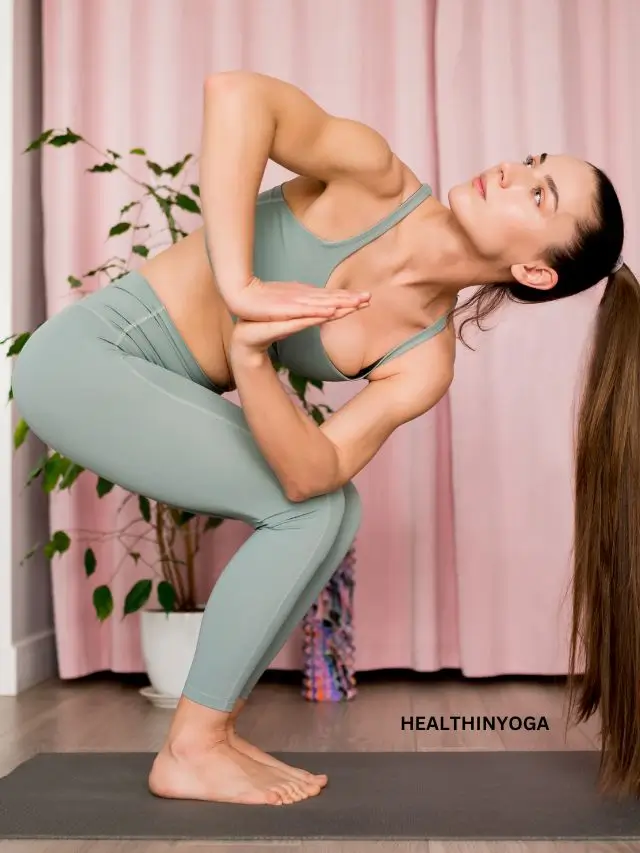
- Stand straight in the mountain pose (TADASANA) the basic pose. your feet hip-width apart and keep your arms aside.
- Firmly press your feet on the ground with your toes. That can help to maintain a balanced stable posture engage the core and lengthen your spine.
- Now coming into a basic chair pose (Utkatasana) as we already explained the entire process. How to do chair pose (Utkatasana).
- Now bring your palm in front of your chest and joint both palms together in a prayer pose (Anjali Mudra).
- Do not hunch your back forward spine should stay long and the chest should be lifted.
- Inhale then exhale twist your torso by rotating to the right side and hips in the forward direction.
- Now press your left elbow over the outer part of your right thigh. That can help you to deepen the twist. It will provide you more stable and balanced posture.
- Press your plans together in prayer positions (Anjali Mudra). In the front on your chest right-hand side.
- Keep balancing your body weight in your heels and keep your chin away from the chest.
- Hold this posture for 5-10 breaths or as long as you are comfortable. You can gradually increase the time according to your stamina.
- To release the pose exhale untwist your torso and bring your palms back. Straight your legs and come into mountain pose.
- Repeat this pose with the other side and you can repeat the same pose 4-5 times with each side.
Contraindications Of The Revolved Chair Pose
This pose is an advanced and challenging variation of the Chair pose. The twisting motion of the torso requires lots of flexibility and stamina to hold. It comes with some limitations and risk factors included with this pose. Please read them carefully before performing this pose here we discuss some of them
- Suppose you have a severe injury or recent surgery on the spine like slip-disc, and sciatica. They do not perform this pose it can worsen the spine condition.
- A person has chronic pain in the ankle, knee, and shoulders. They should avoid this pose, which can cause increased pain.
- Pregnant women and senior citizens with severe balancing issues. They should avoid this pose because it requires balance and stability.
- A person with vertigo, migraine, weak body, high or low blood pressure. They should avoid doing this pose, which can cause falling.
Conclusions
The revolved chair pose shows perfect balance and stability of the body. Anatomically, it affects the entire body, including the hips, core, and shoulders. It strengthens the quad, hamstring, buttocks, and thigh muscles. Regular practice of this pose makes you more flexible and strong. These variation challenges enhance mental and physical health and well-being. The twisting motion of this pose plays a key role in improving the body’s flexibility.
If you have any queries or suggestions, please leave a comment. We will pleased to answer all your queries. Thank you.

Honey is a certified yoga instructor with training from Patanjali Yogpeeth, Haridwar. With four years of dedicated teaching experience, she specializes in using yoga to improve spinal health, build core strength, and help people find relief from chronic pain. Her mission is to make the transformative power of yoga accessible to everyone.

